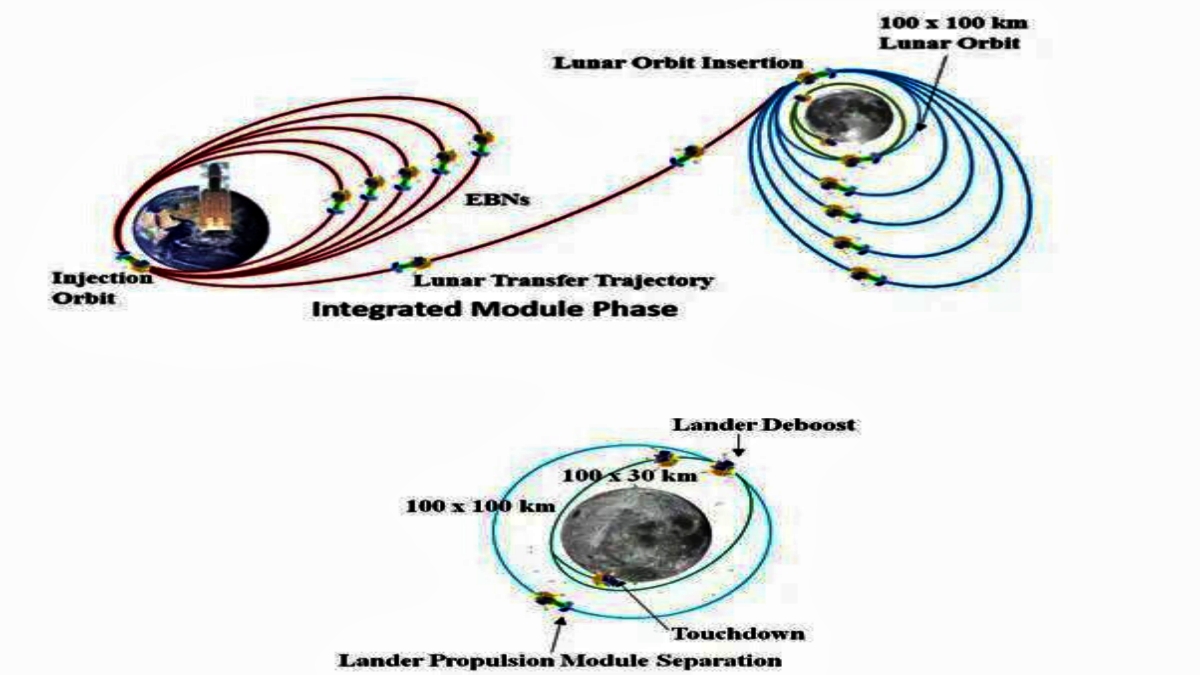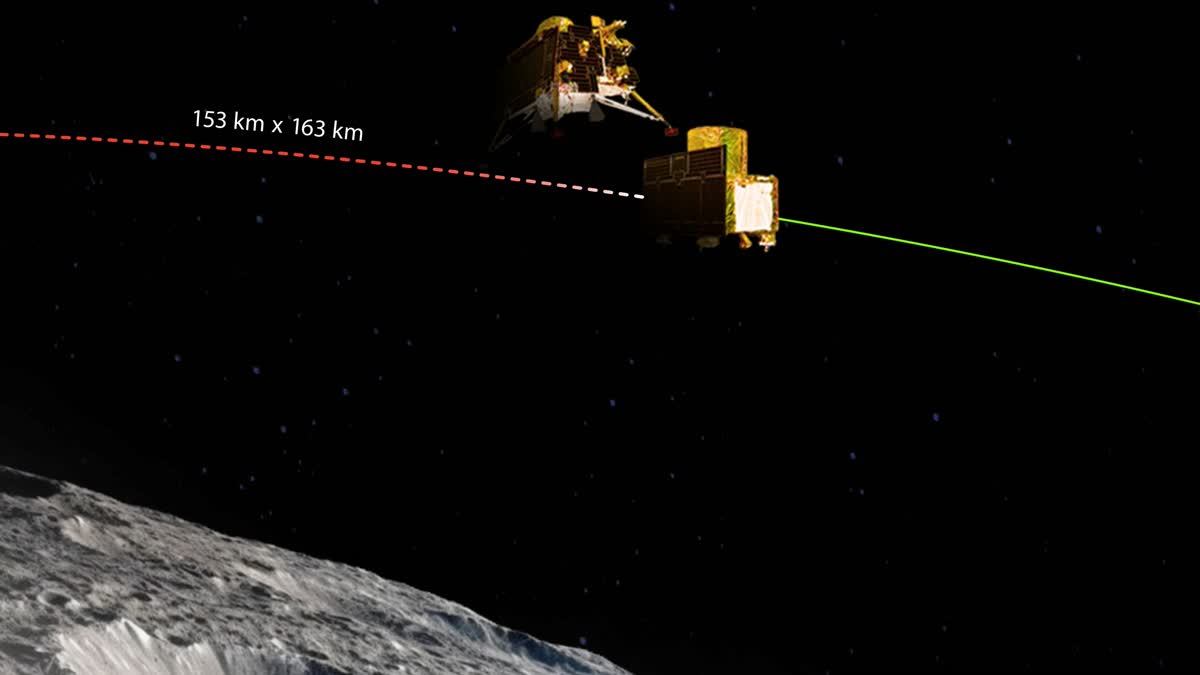Bengaluru: India's ambitious Chandrayaan-3 mission has successfully undergone separation of the Propulsion Module and the Lander Module on Thursday after a hitting an important mark of final lunar-bound orbit manoevre on Wednesday.
"‘Thanks for the ride, mate! said the Lander Module (LM)."
"LM is successfully separated from the Propulsion Module (PM). LM is set to descend to a slightly lower orbit upon a deboosting planned for tomorrow around 1600 Hrs., IST. Now, (India) has 3 Satellites around Moon," the Indian Space Research Organisation, wrote in an X (formerly known as Twitter) post.
-
Chandrayaan-3 Mission:
— ISRO (@isro) August 17, 2023 " class="align-text-top noRightClick twitterSection" data="
‘Thanks for the ride, mate! 👋’
said the Lander Module (LM).
LM is successfully separated from the Propulsion Module (PM)
LM is set to descend to a slightly lower orbit upon a deboosting planned for tomorrow around 1600 Hrs., IST.
Now, 🇮🇳 has3⃣ 🛰️🛰️🛰️… pic.twitter.com/rJKkPSr6Ct
">Chandrayaan-3 Mission:
— ISRO (@isro) August 17, 2023
‘Thanks for the ride, mate! 👋’
said the Lander Module (LM).
LM is successfully separated from the Propulsion Module (PM)
LM is set to descend to a slightly lower orbit upon a deboosting planned for tomorrow around 1600 Hrs., IST.
Now, 🇮🇳 has3⃣ 🛰️🛰️🛰️… pic.twitter.com/rJKkPSr6CtChandrayaan-3 Mission:
— ISRO (@isro) August 17, 2023
‘Thanks for the ride, mate! 👋’
said the Lander Module (LM).
LM is successfully separated from the Propulsion Module (PM)
LM is set to descend to a slightly lower orbit upon a deboosting planned for tomorrow around 1600 Hrs., IST.
Now, 🇮🇳 has3⃣ 🛰️🛰️🛰️… pic.twitter.com/rJKkPSr6Ct
According to the ISRO, Chandrayaan-3 consists of an indigenous propulsion module, lander module, and a rover with an objective of developing and demonstrating new technologies required for inter-planetary missions.
What is Propulsion Module's role? The propulsion module will carry the lander and rover from injection orbit to till 100 km lunar orbit. It also carries a Spectro-polarimetry of Habitable Planetary Earth (SHAPE) payload to study the spectral and polarimetric measurements of earth from the lunar orbit.
SHAPE is aimed at aiding future discoveries of smaller planets in reflected light would allow us to probe into variety of Exo-planets which would qualify for habitability (or for presence of life), the space agency said.
The main function of Propulsion Module is to carry the LM from launch vehicle injection orbit to till Lander separation, it said.
The mission command has been preparing for separation of the lander module -- comprising the lander and rover -- from the propulsion module.
"Today's successful firing, needed for a short duration, has put Chandrayaan-3 into an orbit of 153 km x 163 km, as intended. With this, the lunar bound manoeuvres are completed. It's time for preparations as the Propulsion Module and the Lander Module gear up for their separate journeys," ISRO said in a post on X (formerly Twitter).
Separation of the lander module from the propulsion module is planned for August 17, it said.
Following its launch on July 14, the Chandrayaan-3 spacecraft entered into lunar orbit on August 5, following which orbit reduction manoeuvres were carried out on August 6, 9, 14 and 16.
What next? As the mission progressed, a series of manoeuvres were conducted by ISRO to gradually reduce Chandrayaan-3's orbit and position it over the lunar poles.
After separation, the lander is expected to undergo a "deboost" (the process of slowing down) to place it in an orbit where the Perilune (closest point to the Moon) is 30 kilometres and Apolune (farthest point from the Moon) is 100 km.
From this orbit, the soft landing on the south polar region of the Moon will be attempted on August 23, ISRO has said.
What ISRO chairman says? The space agency's chairman S Somanath recently said that the most critical part of the landing is the process of bringing down the velocity of the lander when it begins its descent from a height of 30 km to the final landing (position), and that the ability to transfer the spacecraft from horizontal to vertical direction is the "trick we have to play" here.

"The velocity at the starting of the landing process is almost 1.68 km per second, but this speed is horizontal to the surface of the moon. The Chandrayaan-3 here is tilted almost 90 degrees. It has to become vertical. So, this whole process of turning from horizontal to vertical is a very interesting calculation mathematically. We have done a lot of simulations. It is here where we had the problem last time (Chandrayaan-2)," Somanath explained.
Further, it has to be ensured that fuel consumption is less, the distance calculation is correct, and all the algorithms are working properly, he added.
"Extensive simulations have been done, guidance designs have been changed, and a lot of algorithms have been put in place to make sure that in all these phases the required dispersions are handled...to attempt to make a proper landing," he said.
What happened so far? Over seven moves in the three weeks since the July 14 launch, ISRO lifted the Chandrayaan-3 spacecraft into orbits farther and farther away from Earth. Then, on August 1 in a key manoeuvre -- a slingshot move -- the spacecraft was sent successfully towards the Moon from Earth's orbit.
Following this trans-lunar injection, Chandrayaan-3 escaped from orbiting the Earth and began following a path that would take it to the vicinity of the Moon, and eventually into Moon's orbit.
Chandrayaan-3 is a follow-on mission to Chandrayaan-2 (2019) to demonstrate end-to-end capability in safe landing and roving on the Moon's surface.
The mission objectives of Chandrayaan-3 are to demonstrate safe and soft landing on the lunar surface, to demonstrate the rover operating on the Moon, and to conduct in-situ scientific experiments.
The lander will have the capability to soft land at a specified lunar site and deploy the rover that will carry out in-situ chemical analysis of the Moon's surface during the course of its mobility.
The lander and the rover are carrying scientific payloads to carry out experiments on the lunar surface. (with PTI inputs)



